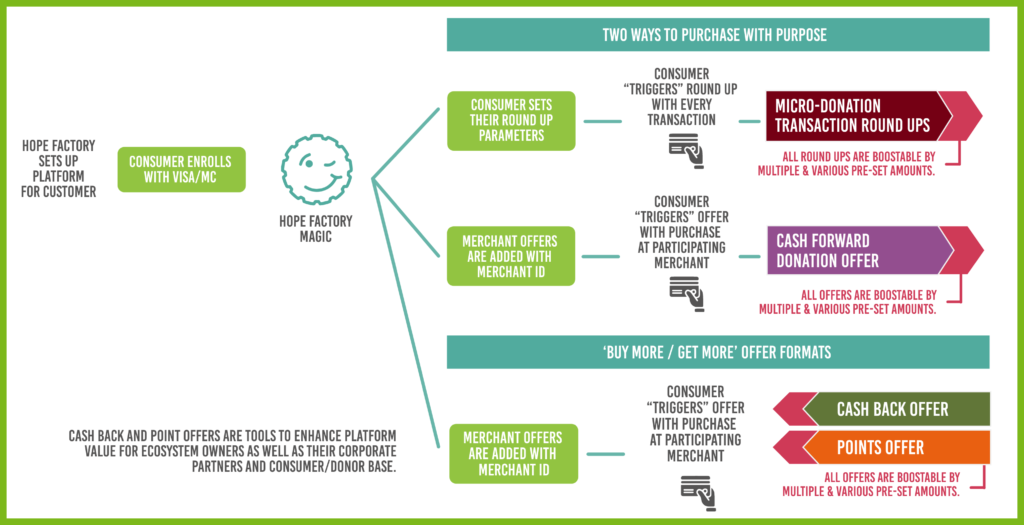The fundraising landscape in 2023 is not the fundraising landscape we used to know.
In the past few years, the world has witnessed massive shifts in all aspects of fundraising and giving, from donation style and motivation to demographics.
As the fundraising industry is undergoing a multitude of changes (for the better), Hope Factory is paying close attention to these four trends:
- People are “spending for good.”
- The younger generation is now a priority.
- Cash is well on its way out and online fundraising is booming.
- Adapting to open banking and card-linking is the future of fundraising (and banking).
These four changes are going to heavily impact fundraising, giving, and donating more than we know… and we’re really looking forward to it.
Trend #1: People Are “Spending for Good”
Within the fundraising sphere — and outside of it, too — we’re seeing a massive shift in consumer spending habits toward conscious consumerism. Individuals are choosing to “spend for good,” gravitating toward organizations that align with their morals and values.
In a 2018 study on purpose-led brands, Accenture Strategy found that 52% of people were drawn to brands that stood for something outside of their products, and 62% of people wanted to support companies that took a stance on pertinent issues.
CanadaHelps’ Black Solidarity Fund (BSF) is a prime example of people’s willingness to “spend for good” and stand behind organizations with a purpose. The BSF raised over $1.9M in donations from 5,000 Canadians because people rallied together to give to a good cause.
In 2023, we’re continuing to see conscious consumption and “spending for good” dominate both the fundraising and purchasing spheres… and we think that it’s here to stay.
Trend #2: Young People Are Now the Priority
Many fundraising-focused organizations prioritize the older “Middle Donor” demographic for two main reasons. Not only do organizations (unsurprisingly) prefer to stay where the money is, but harnessing younger donors has been difficult and expensive in the past.
However, as the industry takes a hard look at the effectiveness of its acquisition and retention strategies — and initiatives shift to embrace “spending for good” — it’s no surprise that we’re seeing a shift in fundraising demographics, too.
Young people — individuals from ages 18 to 40 — are stepping into the fundraising spotlight, becoming increasingly important to organizations, non-profits, and businesses alike.
But, if the average Canadian donor is 42 years old, why bother with young folks?
Put simply, young folks are the future of fundraising.
The PayPal Giving Fund of Canada calls young people the “future of growth in giving,” encouraging organizations to look at the younger generation as drivers in philanthropic change, especially with technology. The fundraising sector will need to look to this younger generation to pave the way for tech-focused giving and digital-first fundraising.
Although young people have historically been at the bottom of the “frequent donor” list, we’re seeing the fundraising sector adapt to the fast-moving younger generation and empowering the donors of our future.
Trend #3: Cash Is Out, Digital Is In
One of the simplest lessons we can learn from young folks (who we’re now listening more carefully to) is that technology is the way of the future — payments and fundraising included.
The biggest tech trend we’re seeing with giving-related payments is that cash is “out,” and digital payments are “in.”
Online donations have been skyrocketing since 2020, reflecting Canada’s increasing reliance on credit cards and debit cards instead of cash.
With 9 in 10 Canadians owning a credit card and most consumers preferring contactless payments, Moneris predicts that only 10% of money spent in Canada will be cash by 2030.
As payment technologies continue developing in 2023 and beyond, we’ll be watching the fundraising sector adapt in tandem… or get left behind.
Trend #4: Open-Banking & Card-Linking Are The Future
In addition to more frequent online donations, we’re also seeing the fundraising sector coming to terms with new advancements and capabilities in finance like open banking.
Open banking, sometimes called “consumer-directed finance,” is slowly but surely making its way to the Canadian market… but Canadians are already on the banking tech train. A 2021 study by MasterCard found that 95% of Canadian participants already used some form of banking technology to move and reallocate finances.
When Canadians (eventually) have access to open banking, it also means they have access to increased personal data control, flexible products, services, and applications, and — perhaps most importantly — convenience and ease of financial management.
Donor-focused organizations that integrate to offer more convenience with open banking are more likely to gain donations from Canadians.
In 2023, we’re watching the fundraising sector get on board with the opportunities of open banking, figuring out how to adapt its current models and strategies to a new financial future.
Looking Ahead with Hope Factory
Hope Factory has been watching these changes happen with excitement, from spending for good to prioritizing young donors, shifting giving online, and welcoming open banking.
Frankly, changes like these are why we exist.
Hope Factory was created to “help the people who help people,” harnessing the power of spending for societal good. We’ve happily embraced an online-first world by creating a platform leveraging the card-linking/open banking tech that younger generations know and love.
While the world saw a rapidly-evolving fundraising sphere, Hope Factory saw a world of opportunity to tie giving to spending, whether through rounding up transactions to support a cause you’re passionate about or “purchasing with purpose” from value-aligned merchants and brands.
Hope Factory is changing how we think of “Mass Donors,” corporate partnerships, and donations, creating thriving communities of giving to support our world’s ever-increasing societal needs.


